The Teaching Aquarium at Our Aquarium Training School
One of the main factors that sets the Aquarium Science Program at Oregon Coast Community College apart from other aquarium college programs is our dedicated Teaching Aquarium on the OCCC campus. This 10,000-square foot purpose-built facility offers our students real hands-on experience as they learn the science, skills and craft of working with fish and invertebrates and maintaining aquatic life support systems. There are more than sixteen different life support systems in our facility that were specifically designed and built to be teaching systems that exemplify the best practices of our industry. Read further to explore the different areas within our one-of-a-kind aquarium training school.
General Information
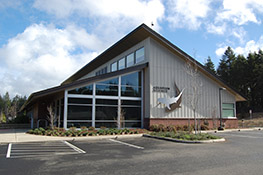 The Aquarium Science (AQS) building was constructed in 2010 and was opened for classes in the fall of 2011. This facility, located at the Central Oregon Coast Community College campus in Newport, was built with State and Lincoln County funds. The AQS building is designed to be a teaching facility and laboratory that mimics the organization and set-up of working spaces typical of a public aquarium facility. Spaces include a water quality lab, teaching lab, animal holding lab, food preparation lab, life support room and workshop. The facility was built with operational and energy efficiency in mind through the use of recirculating heat and solar panels. The primary purpose of our AQS facility is to provide an environment for Aquarium Science students to gain knowledge and hands-on skills that will assist them in the Aquarium Science industry.
The Aquarium Science (AQS) building was constructed in 2010 and was opened for classes in the fall of 2011. This facility, located at the Central Oregon Coast Community College campus in Newport, was built with State and Lincoln County funds. The AQS building is designed to be a teaching facility and laboratory that mimics the organization and set-up of working spaces typical of a public aquarium facility. Spaces include a water quality lab, teaching lab, animal holding lab, food preparation lab, life support room and workshop. The facility was built with operational and energy efficiency in mind through the use of recirculating heat and solar panels. The primary purpose of our AQS facility is to provide an environment for Aquarium Science students to gain knowledge and hands-on skills that will assist them in the Aquarium Science industry.
Student Lobby
 The spacious, open lobby of this part of our facility allows AQS students to prepare for their next class, lab, or exam, relax and study or grab a quick bite, meet with other members of their study group or gather together while instructors deliver their opening remarks before lab. The tables and chairs allow students to compare notes and engage with their mentors and instructors in a unique type of formal and informal instruction found in very few other aquarium training colleges. The fridge, coffee machine, microwave and other essential components of student life, along with the natural light pouring through the huge windows make this convivial space conducive to learning and esprit de corps.
The spacious, open lobby of this part of our facility allows AQS students to prepare for their next class, lab, or exam, relax and study or grab a quick bite, meet with other members of their study group or gather together while instructors deliver their opening remarks before lab. The tables and chairs allow students to compare notes and engage with their mentors and instructors in a unique type of formal and informal instruction found in very few other aquarium training colleges. The fridge, coffee machine, microwave and other essential components of student life, along with the natural light pouring through the huge windows make this convivial space conducive to learning and esprit de corps.
Teaching Lab
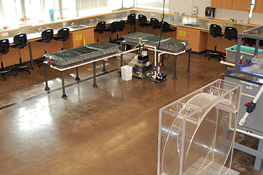 In addition to various aquatic life support teaching systems for teams of students to maintain each term, the Teaching Lab also provides whiteboards, a screen and projector, instructor’s table and bookshelves full of reference materials for students to read and use as source material for reports and other assignments. Around the perimeter of the room are stainless steel counters and chairs, where students can perform dissections and other lab activities with plenty of space for notebooks, microscopes, surgical instruments and other learning tools. In addition to some smaller systems built for freshwater plants, poison dart frogs and other amphibians, the major life support systems in this room include:
In addition to various aquatic life support teaching systems for teams of students to maintain each term, the Teaching Lab also provides whiteboards, a screen and projector, instructor’s table and bookshelves full of reference materials for students to read and use as source material for reports and other assignments. Around the perimeter of the room are stainless steel counters and chairs, where students can perform dissections and other lab activities with plenty of space for notebooks, microscopes, surgical instruments and other learning tools. In addition to some smaller systems built for freshwater plants, poison dart frogs and other amphibians, the major life support systems in this room include:
- TL-1 – This system is specifically designed to teach students how to work with and culture jellyfish. The main kreisel tank on this system exemplifies how proper flows keep these delicate animals moving and pulsing in the water column. Other parts of the system contain pseudokreisels and other smaller tanks so that students learn how to care for each jellyfish life stage from polyp to strobila to ephyrae.
- TL-2 – This system has a coral reef display, along with a large trough tank, where students can learn how to propagate coral frags and properly care for them. Other parts of this teaching system have coral-specific life support components to help students understand the many facets of coral husbandry, including water chemistry, laminar flow dynamics, proper lighting and other aspects of coral husbandry.
- TL-3 – TL-3 is a temperate marine system with teleosts and invertebrates usually found in the intertidal zone and a few other habitats. Crabs, sculpins. anemones, urchins and other animals receive care and dietary enrichment tailored to their unique needs and students assigned to this system learn how to maintain a chiller, which governs temperature control.
- TL-4 – This tropical marine system serves AQS students as a tropical marine anemone propagation system. Powerheads and system inflows animate the tentacles of anemones and the LED lighting above the system allows the symbiotic photosynthetic algae living in the tissue of these anemones to provide energy and nutrients the hosts need to thrive and clone themselves via binary fission.
Animal Holding Lab
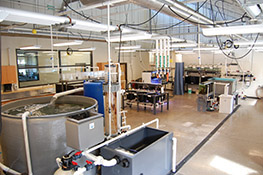 The largest room in our aquarium training school, Animal Holding has extensive stainless steel counters on both sides of the room, along with lab chairs and a wide range of learning materials. Like most of the rest of the facility, various water loops, electrical power, low-pressure airlines, and other essential elements of life support infrastructure are suspended above the various teaching systems, which exemplify best practices and are an important part of the learning experience for AQS students. These life support systems include:
The largest room in our aquarium training school, Animal Holding has extensive stainless steel counters on both sides of the room, along with lab chairs and a wide range of learning materials. Like most of the rest of the facility, various water loops, electrical power, low-pressure airlines, and other essential elements of life support infrastructure are suspended above the various teaching systems, which exemplify best practices and are an important part of the learning experience for AQS students. These life support systems include:
- H-1 – H-1 is a tropical marine holding system, which contains a variety of saltwater teleosts for students to feed and provide care for. Students assigned to this system must also proactively maintain the various components of the life support system and develop enrichment and feeding strategies for these animals.
- H-2 – This aquaponics system is designed and built to illustrate an innovative means of nutrient export. The herbs, vegetables, leafy greens and flowers growing in the upper trough of the system remove nutrients produced by the freshwater animals living in the system, providing fresh food for some of the animals in the Teaching Aquarium and illustrating how to maintain optimal water chemistry parameters while also reducing water use.
- H-3 – This system is designed and built for broodstock and larval fish rearing. Students with particular interest in learning how to get a job working with fish in aquaculture facilities are drawn to this system, as one side has three tanks for breeding pairs and the other side has three upwelling tanks optimized for larval fish husbandry, with black tanks walls to help larvae find, track and eat live foods cultured in another part of our aquarist training school.
- H-4 – Research facilities working with zebrafish and other species of small fishes with fully mapped genomes provide students with another career path they may not have considered before enrolling in the AQS Program. This system exemplifies research systems with rows of smaller tanks, usually containing different phenotypes of broodstock and research animals, along with the life support components to keep these animals healthy.
- H-5 – H-5 is a tropical freshwater system with a large community tank and a smaller tank for specimens that would not thrive in the larger and more competitive environment of the main exhibit. AQS students seeking more experience with freshwater animals have a chance to work with large cichlids, catfishes, angelfish and other specimens often raised in freshwater ornamental aquaculture facilities.
- H-6 – While primarily an elasmobranch holding system with different tropical species of sharks in the wider and shallower tank, H-5 also has a taller and deeper holding tank, with several different species of tropical marine fish that require different diets and feeding strategies. The students working on this system learn how to work with and maintain larger life support system (LSS) components often found behind the scenes in public aquaria.
- H-7 – The second-largest system in our aquarium training program, H-7 is a temperate “SoCal” tank, with a shark and fishes found in the cooler waters of the central and southern California coast. This system also allows students learning the skills to get a job working with fish to work with bioreactors, protein skimmers, sand filters and other larger LSS components.
Food Prep Lab
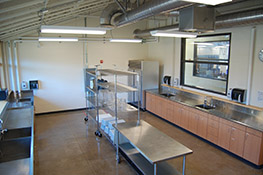 This room is set up just like the areas where foods are prepared for all kinds of aquatic animals in public aquaria, research facilities, fish hatcheries and other professional environments. Stainless steel counters, a variety of knives and other food fabrication tools, scales for portion control, professional grade refrigeration and other tools round out this area of the Teaching Aquarium, along with strict protocols for preventing cross contamination. In Food Prep, AQS students learn how to properly size the foods they prepare for different types of animals, rotate stock to keep it fresh and nutritious, and maintain strict standards for cleanliness and organization. In one corner, there’s a designated Culture Area, where students learn how to hatch, raise and fortify a variety of live foods, further exemplifying how proper nutrition protects and promotes animal health.
This room is set up just like the areas where foods are prepared for all kinds of aquatic animals in public aquaria, research facilities, fish hatcheries and other professional environments. Stainless steel counters, a variety of knives and other food fabrication tools, scales for portion control, professional grade refrigeration and other tools round out this area of the Teaching Aquarium, along with strict protocols for preventing cross contamination. In Food Prep, AQS students learn how to properly size the foods they prepare for different types of animals, rotate stock to keep it fresh and nutritious, and maintain strict standards for cleanliness and organization. In one corner, there’s a designated Culture Area, where students learn how to hatch, raise and fortify a variety of live foods, further exemplifying how proper nutrition protects and promotes animal health.
Live Culture Lab
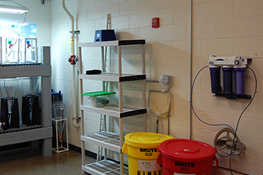 The Live Culture Lab is an area of Food Prep designated for the culturing of live food items (algae, rotifers, etc.) for animals kept in life support systems throughout the facility. This area is equipped with its own water filtration and has central aeration supplied from the Life Support Room. Various culture vessels and equipment specific to rearing live food items are contained in this area. Some of the classes that use the Live Culture lab include: Biology of Captive Invertebrates (AQS 220), and Reproduction and Nutrition of Aquatic Animals (AQS 232).
The Live Culture Lab is an area of Food Prep designated for the culturing of live food items (algae, rotifers, etc.) for animals kept in life support systems throughout the facility. This area is equipped with its own water filtration and has central aeration supplied from the Life Support Room. Various culture vessels and equipment specific to rearing live food items are contained in this area. Some of the classes that use the Live Culture lab include: Biology of Captive Invertebrates (AQS 220), and Reproduction and Nutrition of Aquatic Animals (AQS 232).
Water Quality Lab
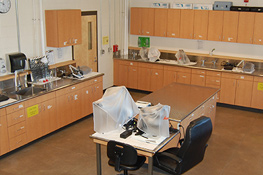 Understanding water chemistry and the dynamics of how it changes over time in any kind of aquatic life support system is integral for providing optimal care for aquatic animals in any kind of facility. In this area of the Teaching Aquarium, students learn how to obtain water samples from different systems while also promoting and protecting biosecurity. This lab features a variety of bench top and mobile water quality testing instruments that allows students to perform routine tests properly, document the results and then interpret this data in order to gain insight into the health of the systems and the animals living in them. In addition to the pH meters, spectrophotometers, conductivity meters, refractometers and other instruments found in professional water quality labs, students also learn how to test samples using less robust and exacting testing methods in order to round out their education in aquarium science.
Understanding water chemistry and the dynamics of how it changes over time in any kind of aquatic life support system is integral for providing optimal care for aquatic animals in any kind of facility. In this area of the Teaching Aquarium, students learn how to obtain water samples from different systems while also promoting and protecting biosecurity. This lab features a variety of bench top and mobile water quality testing instruments that allows students to perform routine tests properly, document the results and then interpret this data in order to gain insight into the health of the systems and the animals living in them. In addition to the pH meters, spectrophotometers, conductivity meters, refractometers and other instruments found in professional water quality labs, students also learn how to test samples using less robust and exacting testing methods in order to round out their education in aquarium science.
Student Workshop
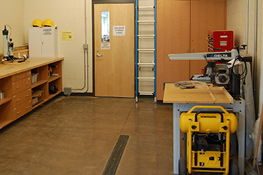 The Student Workshop is equipped with materials, machinery, and tools intended to aid students in the design and construction of various aquarium science related projects. Proper handling and use of each material, machine, and tool in the workshop are taught throughout the curriculum. The main courses that utilize the workshop in support of associated activities and projects include: Intro to Aquarium Science (AQS 100), Life Support Design and Operation (AQS 240) and Exhibits and Interpretation (AQS 252).
The Student Workshop is equipped with materials, machinery, and tools intended to aid students in the design and construction of various aquarium science related projects. Proper handling and use of each material, machine, and tool in the workshop are taught throughout the curriculum. The main courses that utilize the workshop in support of associated activities and projects include: Intro to Aquarium Science (AQS 100), Life Support Design and Operation (AQS 240) and Exhibits and Interpretation (AQS 252).
Life Support Systems Room
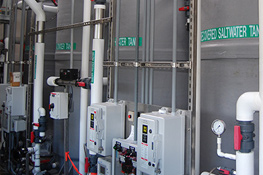 The Life Support Systems (LSS) Room is equipped with water reservoirs that provide the make-up supply of warm freshwater, warm saltwater, and cold saltwater. The room also contains a water recovery system to aid in the recycling of used aquarium water from the facility. Water lines from each of the different containment vessels are labeled and run to supply locations throughout the facility. The LSS room also contains a centralized air blower, which supplies low pressure air to various locations throughout the facility. Although not designed as an instructional space for classes, the LSS room does support demonstration activities for the Life Support Design and Operation course (AQS 240).
The Life Support Systems (LSS) Room is equipped with water reservoirs that provide the make-up supply of warm freshwater, warm saltwater, and cold saltwater. The room also contains a water recovery system to aid in the recycling of used aquarium water from the facility. Water lines from each of the different containment vessels are labeled and run to supply locations throughout the facility. The LSS room also contains a centralized air blower, which supplies low pressure air to various locations throughout the facility. Although not designed as an instructional space for classes, the LSS room does support demonstration activities for the Life Support Design and Operation course (AQS 240).
Hospital/Quarantine
This area of our aquarium training school is isolated from other parts of the facility and contains four or more different H/Q life support systems for properly quarantining and caring for new arrivals to the collection and isolating animals that require medical treatment. While strict biosecurity protocols are implemented and enforced throughout the Teaching Aquarium, these protocols are enhanced further in this room in order to reinforce the importance of biosecurity and how these measures protect the health of the entire collection. AQS students drawn to the medical and health management side of the business often request this assignment even though it may restrict their access to other parts of the facility for that term.
An Immersive Learning Environment Unlike any other Aquarist Training Program
A typical day for AQS students begins and ends in our Teaching Aquarium. Before class in the morning, students often perform AM checks and feeds on their assigned systems, along with other assigned duties. After lecture or lab in the afternoon, students conduct PM checks and feeds and receive direction from the professional aquarists serving as mentors in the building. In addition to the formal and informal instruction that occurs in this facility over the course of a day, a month or an academic year, our students also learn the essential team dynamics that transform a cohort of students into an informed, enabled and accomplished aquatic animal husbandry team.
Return to the AQS Home Page

